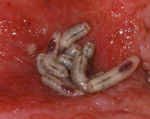Difference between revisions of "Myiasis Producing Flies"
Jump to navigation
Jump to search
| Line 12: | Line 12: | ||
'''[[Calliphoridae|''Calliphoridae'']] | '''[[Calliphoridae|''Calliphoridae'']] | ||
| − | |||
| + | '''[[Chrysomya bezziana|''Chrysomya bezziana'']] | ||
| + | </big> | ||
| Line 20: | Line 21: | ||
| − | |||
| − | |||
| − | |||
| − | |||
| − | |||
| − | |||
| − | |||
| − | |||
| − | |||
| − | |||
| − | |||
| − | |||
| − | |||
| − | |||
| − | |||
| − | |||
| − | |||
| − | |||
| − | |||
| − | |||
| − | |||
| − | |||
| − | |||
| − | |||
| − | |||
| − | |||
| − | |||
| − | |||
| − | |||
| − | |||
| − | |||
| − | |||
| − | |||
| − | |||
| − | |||
| − | |||
| − | |||
| − | |||
| − | |||
| − | |||
| − | |||
| − | |||
| − | |||
Revision as of 20:00, 30 March 2010
| This article has been peer reviewed but is awaiting expert review. If you would like to help with this, please see more information about expert reviewing. |
Introduction
Myiasis is the parasitism of living animals by dipteran larvae. Myiasis can be obligatory or facultative (optional) and is described as cutaneous, nasal or somatic.
Maggot Debridement Therapy
- Human medicine
- Sterile Lucilia sericata maggots used to treat infected and necrotic wounds
- Larvae secrete proteolytic enzymes and antimicrobial agents into the wound
- Larvae do not burrow under the skin or attack healthy tissue
- Veterinary medicine
- Published reports rare
- Recently used successfully to treat a suppurative wound in a donkey that did not respond to conventional medical methods and surgery
Wohlfahrtia spp.
- Obligatory parasite
- Occurs in North America
- Parasite of mink and sometimes humans
Recognition
- Large 8-14mm long
- Pale grey
- Black stripes on thorax
- Black spots on abdomen
Life cycle
- Larvae deposited directly onto host
- No egg stage
- Larvae moult twice on host then fall to ground to pupate
Pathogenesis
- Larvae penetrate intact skin
- Cause boil like swellings
